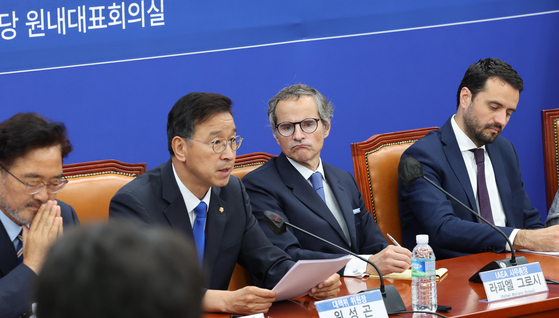Dispelling wild rumors and public anxiety

Hahn Pil-soo
The author is a former director of the Division of Radiation, Transport and Waste Safety of the International Atomic Energy Agency.
As the unrefined view on the issue of the contaminated water from the crippled Fukushima nuclear plant in Japan spreads fast, the fishermen and the self-employed of Korea’s fisheries industry are suffering great damage. While the opinions of experts based on scientific evidence are being ignored, biased views of people without expertise in the field are circulating widely, backed by the bandwagon of political logic. After their unreasonable claims provoked the general public’s anxiety about radiation, not only the fisheries industry but also salt farmers are suffering critical harm.
In January 2011, I was appointed as the director of the Division of Radiation, Transport and Waste Safety of the International Atomic Energy Agency (IAEA). On March 11 of that year, a devastating nuclear accident occurred at the Fukushima Daiichi Nuclear Power Plant. The division is in charge of checking the radiation and nuclear wastes safety, as well as environmental impact assessments. While dealing with the nuclear meltdown in Fukushima, I oversaw the safety issues at the daily briefings for the IAEA member countries. In November 2013, I participated as the deputy head of the IAEA investigation team on the contaminated water management — and got involved in writing and overseeing the investigation report.
It is true that the wastewater from the crippled nuclear plant contains many different kinds of radioactive materials and a high level of contamination. After spending much effort and time, Tokyo Electric Power Company developed a filter system dubbed the “Multi-nuclide Removal Facility (ALPS)” to treat the contaminated water and made efforts to improve and verify its performance. As a result, the IAEA reported that the system was able to remove contaminated materials to the level of meeting international standards.
The Japanese government requested technical feasibility verification from the IAEA prior to discharging the treated contaminated water into the Pacific. So, the IAEA conducted detailed investigations through four visits to Japan and two cross-validation analysis to confirm the results of the investigation. The final report was delivered to Tokyo on July 4.
The credibility of the official final report of the IAEA inspection team is directly related to the integrity of the UN body.

As far as I remember, no IAEA member country has raised doubts about the professional integrity and objectivity of reports from IAEA so far. Eleven experts from concerned parties, including scientists from Korea, Canada, France, China and the United State, have participated in the Fukushima investigation. The claim that the IAEA report was influenced by the Japanese government is akin to a conspiracy theory or ungrounded worries.
The IAEA usually organizes an international expert group in the related fields and dispatches an examination team to the site to investigate various issues and verify the feasibility. Safety standards are strictly applied to the evaluation process of the site inspection to ensure the objectivity and fairness of the investigation. These safety standards are applied with legal binding force to all nuclear safety-related tasks performed under the supervision of IAEA. But it is used as a reference or recommendation without legal binding force for each IAEA member country.
The final IAEA report submitted to Tokyo is the result of checking if Japan’s overall measures related to its plan to discharge the treated water into the sea really meet the IAEA standards. In other words, the report includes evaluation of compliance with the 10 items of the safety principles — the highest-level document for the IAEA safety standards — and the lower seven items of safety requirements under the principles.
During this process, the IAEA apparently conducted an in-depth inspection on the performance of the ALPS and confirmed the treatment capabilities and credibility of the analysis. Furthermore, efforts for continuous verification of the credibility of environment monitoring outcomes, real-time data sharing on the ALPS and discharge facilities’ operation, and the verification of an IAEA office dedicated to the Fukushima plant were also included in the report as the additional role of the IAEA.
As we can see, the IAEA report presented a comprehensive conclusion that Japan’s measures to release the ALPS-treated contaminated water meet the safety standards and that the discharge of the treated wastewater nearly has no impact on humans and the environment. The IAEA concluded that the situation is similar to the cases in which contaminated water from normal operation of nuclear plants in other countries is treated and released to the sea.
The IAEA’s marine environmental impact assessment has reached the conclusion that the marine discharge of the treated water from the Fukushima plant has no effect on the Korean coast. I sincerely hope that the announcement of the report by IAEA, an independent authority on nuclear safety under the United Nations, will dispel rumors and ease public safety concerns.
Translation by the Korea JoongAng Daily staff.










with the Korea JoongAng Daily
To write comments, please log in to one of the accounts.
Standards Board Policy (0/250자)